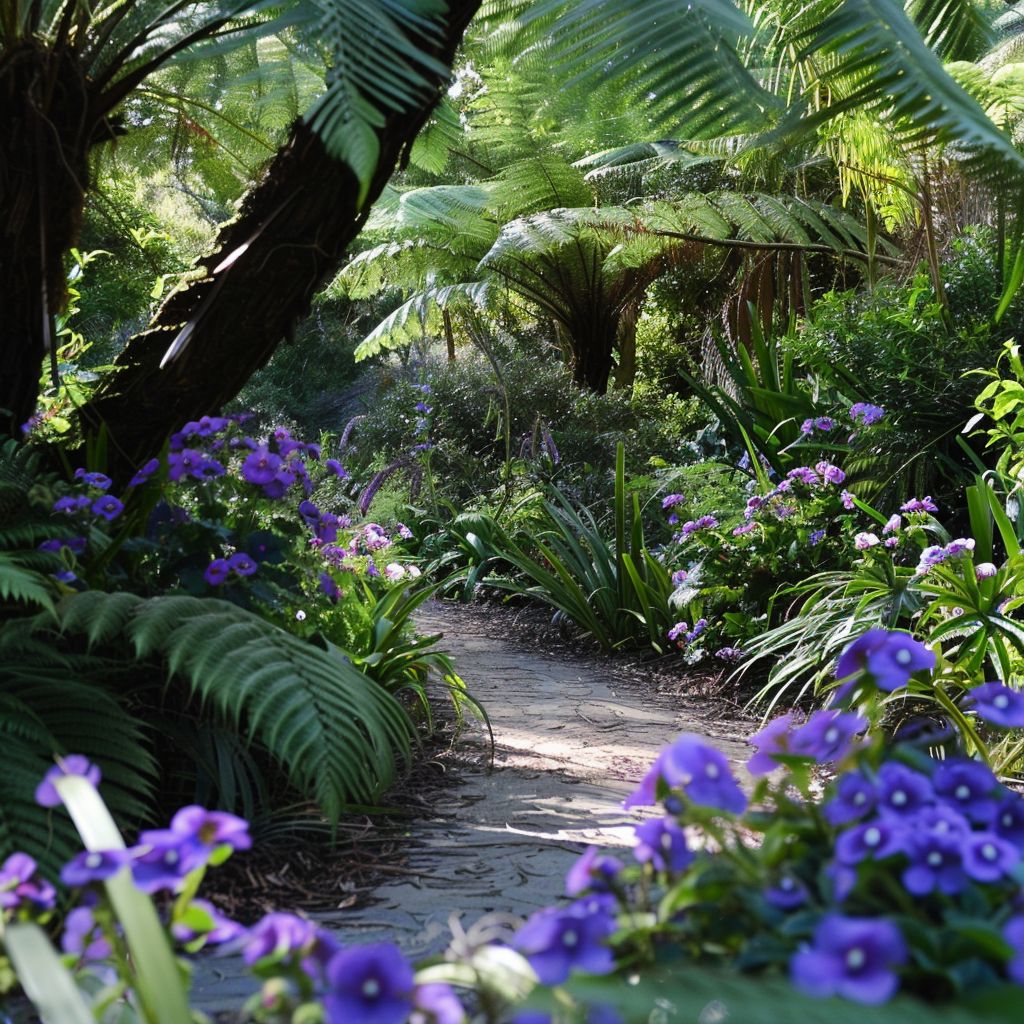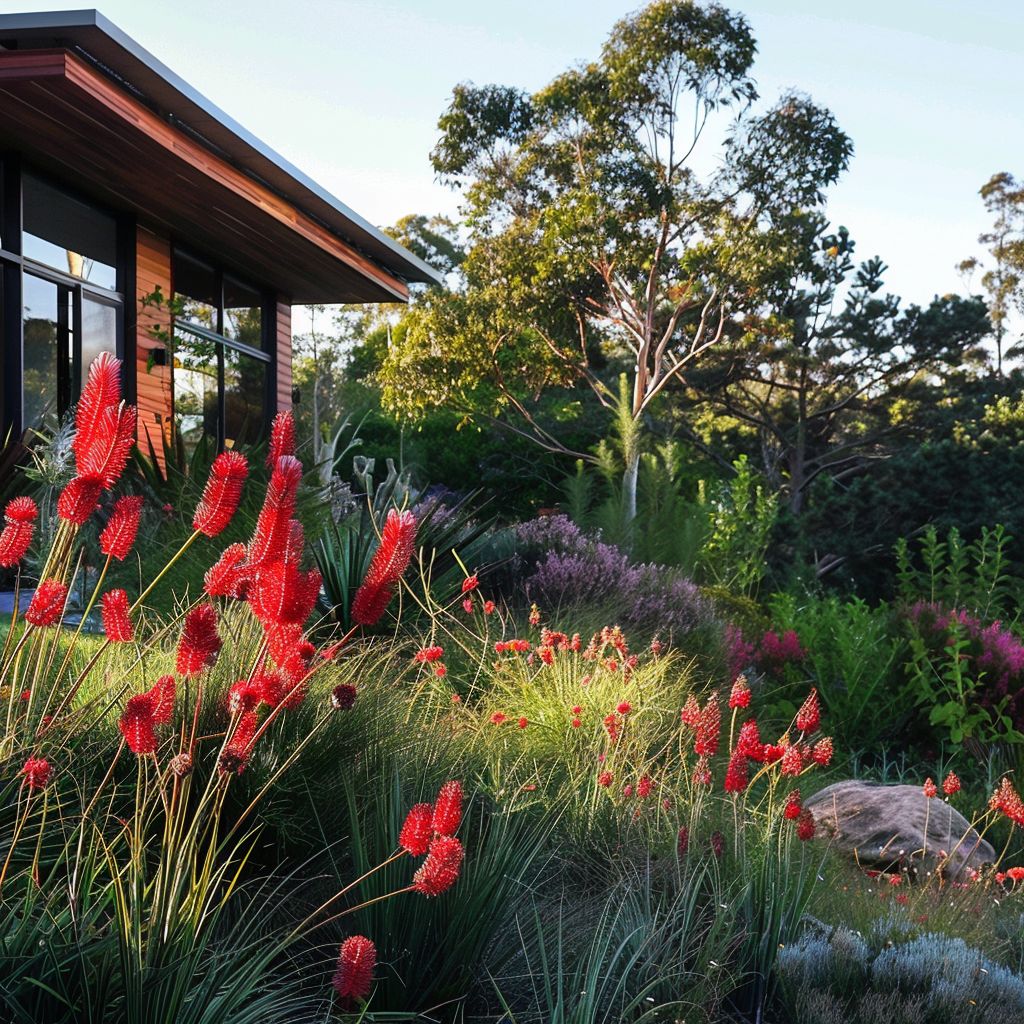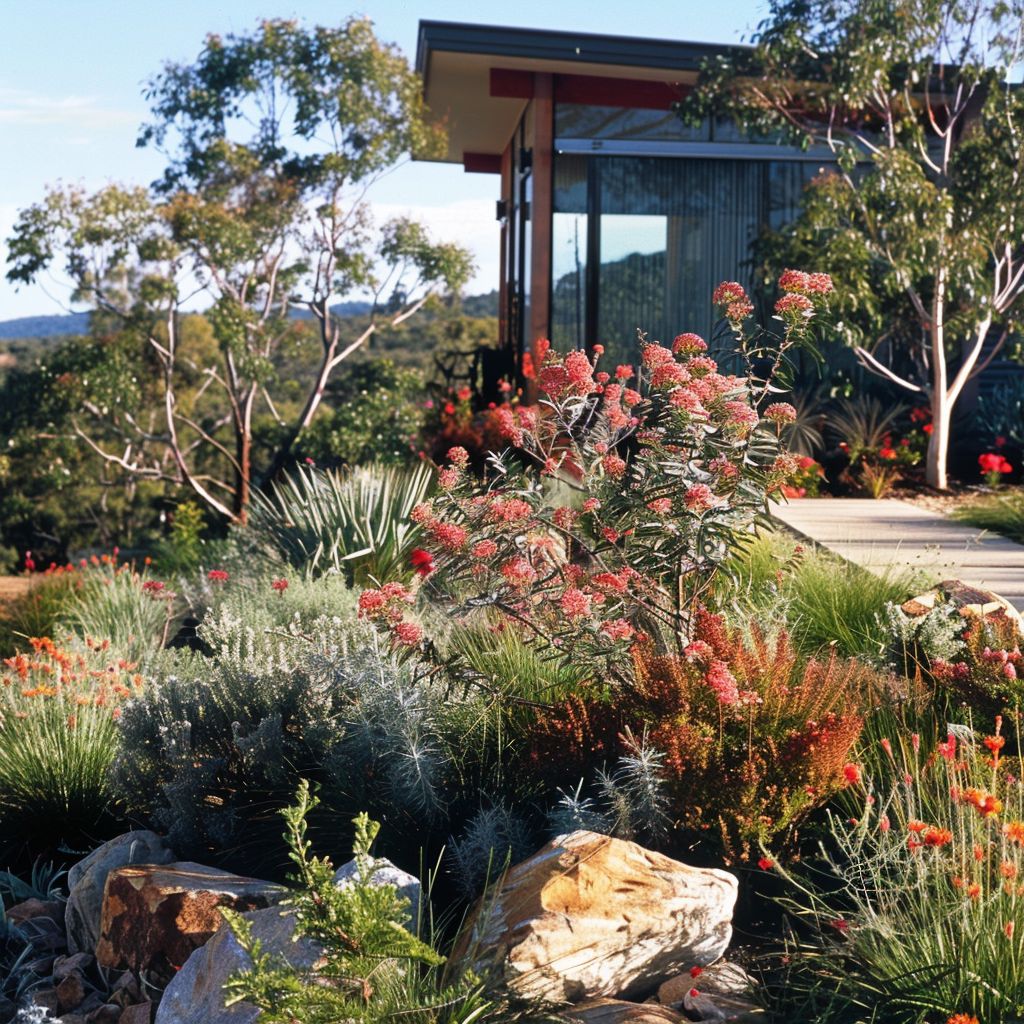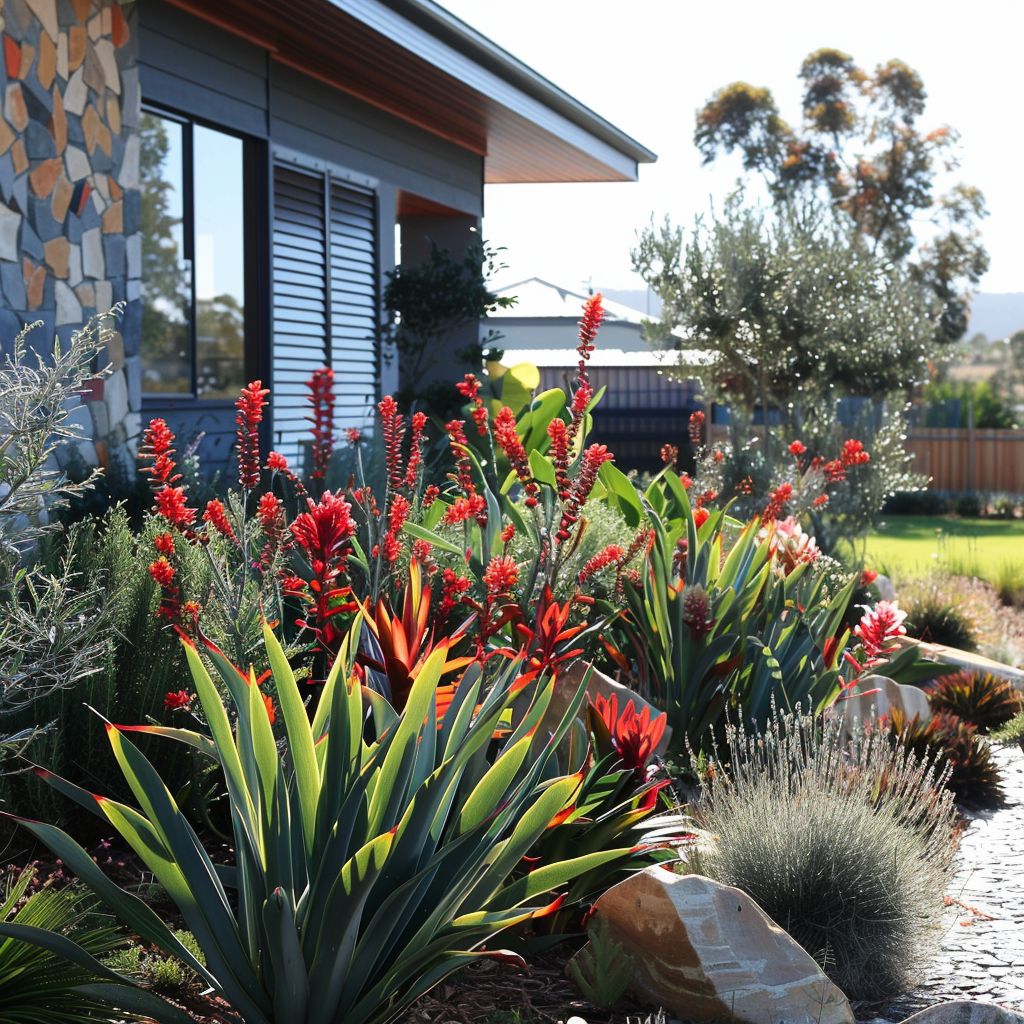Are you looking to transform your garden into a stunning, natural retreat that reflects the unique beauty of Australia? With a renewed interest in native gardens, many are turning to local plant species to create landscapes that are both beautiful and sustainable.
By incorporating native plants, you can establish a garden that not only thrives in the local climate but also fosters a deep connection to the Australian environment.
Dive into these native garden ideas and discover how you can bring a touch of the wild, yet refined, Australian landscape to your own backyard.
Native Australian Garden Design Ideas
Let’s explore some inspiring garden ideas to help you create a breathtaking native Australian yard.
#1. Rainforest Retreat

Transport yourself to the heart of a verdant rainforest by incorporating tree ferns, lilly pillies, and native violets into your garden. These plants thrive in shaded, moist environments, creating a lush and dense understory that evokes the tranquility of a tropical paradise.
Strategically place larger tree ferns as focal points, allowing their graceful fronds to unfurl and create a canopy overhead. Underplant with a tapestry of lilly pillies, violets, and other moisture-loving natives to achieve a truly immersive rainforest experience.
#2. Desert Oasis
For those living in arid climates, a native Australian dry garden can be a stunning and water-wise solution. Embrace the beauty of drought-tolerant species like spinifex, kangaroo paws, and bottlebrushes, which have evolved to thrive in harsh conditions.
These resilient plants boast striking forms, vibrant colors, and intricate textures that add visual interest to your landscape. Arrange them in naturalistic drifts, mimicking the way they grow in the wild, and incorporate gravel or decomposed granite pathways to complete the desert-inspired aesthetic.
#3. Coastal Charm
If you reside near the ocean, consider a coastal garden that celebrates the salt-tolerant natives of Australia’s shorelines. Banksia integrifolia, with its iconic bottlebrush flowers, is a perfect choice, complemented by the delicate blooms of seaside daisies and the aromatic foliage of native rosemary.
Incorporate hardy ground covers like pigface to create a living carpet that can withstand the harsh maritime conditions. These plants not only add visual interest but also provide a welcoming habitat for local wildlife.
#4. Urban Oasis

Even in the heart of a city, you can create a tranquil Australian native garden by incorporating compact species like dwarf lilly pillies, correas, and native grasses. These plants thrive in small spaces and offer a touch of natural beauty amidst the urban landscape.
Incorporate them into raised beds or containers, or use them as borders along pathways or patios. Their low-maintenance nature and adaptability make them ideal for busy city dwellers seeking a connection with nature.
#5. Sculptural Statements
Native Australian gardens offer the perfect canvas for incorporating sculptural elements that complement the natural forms and textures of the plants.
Consider incorporating timber or stone features, such as benches, water features, or artfully placed boulders, to create focal points and add depth to your design. These elements can also serve as functional additions, providing seating areas or defining pathways while enhancing the overall aesthetic.
#6. Ground Cover Tapestry
For a lush and low-maintenance garden, consider creating a tapestry of native ground covers like hibbertias or scaevolas. These spreading plants form a dense, weed-suppressing carpet that requires minimal upkeep once established.
Intersperse them with sculptural elements, such as driftwood or rocks, to add visual interest and create a sense of depth. This approach not only reduces water consumption but also provides a beautiful, naturalistic aesthetic that celebrates the diversity of Australian flora.
#7. Wildflower Meadow

Transform a part of your garden into a wildflower meadow by planting a mix of native wildflowers and grasses. Choose species that bloom at different times to ensure a long-lasting display of color. This type of garden is low maintenance and provides a valuable habitat for pollinators.
Designing Your Native Australian Garden
Creating your native Australian garden involves embracing the local flora and establishing a naturalistic setting. Here’s how you can get started.
Understanding the Basics of Garden Design
Focus on unity and harmony. Use repetitive elements like similar plant types or colours throughout the garden. Balance the size, colour, and texture of your chosen plants. Introduce a water feature to mask unwanted noise and block unsightly views.
Incorporating Indigenous Styles and Themes

Adopt a rustic, weathered look for garden furniture. Use elements like rusty Corten steel fire pits and tree stump seating. Recycled railway sleepers can form low retaining walls. Partial screens create mystery, enticing visitors to explore further.
Selecting Plants for Aesthetic Appeal and Biodiversity
Choose plants that thrive in your local climate. Grevillea and Callistemon attract native birds and offer vibrant flowers. Incorporate a mix of textures and colours with ground covers, shrubs, and trees. Add water features and sandstone pathways to elevate your garden’s natural charm.
Embrace these ideas, and you’ll establish a garden that truly reflects Australia’s distinct beauty.
Key Native Plants for Your Australian Garden
Ground Covers and Bushes
Ground covers and bushes play a vital role in filling out your garden. Native violets (Viola hederacea) are perfect for shaded areas. Poa grasses (Poa spp), conversely, thrive in sunnier spots and add texture. If you prefer something more vibrant, try Correa species, which offer beautiful flowers and are easy to maintain.
Iconic Australian Trees and Shrubs
Iconic trees and shrubs create structure and visual interest. The Eucalyptus tree is a classic, providing both shade and a home for wildlife. For a more contained look, the Lilly Pilly (Syzygium spp) is ideal and works well for hedging. For smaller spaces, the Kangaroo Paw (Anigozanthos spp) offers unique foliage and striking flowers.
Colourful Flowering Natives

Colourful flowering natives bring vibrant hues to your garden. Grevillea species are popular, attracting birds and producing bright blossoms year-round. Bottlebrush (Callistemon spp) is another excellent choice, with its cylindrical flowers adding a splash of colour. Don’t forget the Waratah (Telopea spp); its stunning red flowers are an Australian icon and a must-have for any native garden.
Practical Tips for Building Your Native Garden
Creating a native garden can be rewarding. Here are some practical tips to guide you.
Soil Preparation and Planting Techniques
Test your soil before planting. Native Australian plants often prefer well-drained soil. To achieve this, consider mixing sand or small gravel into your soil. Digging holes at least twice as wide as the plant’s root ball helps roots spread easily.
Water Management in Drought-Prone Areas

Choose drought-tolerant plants and indigenous species like Grevillea and Eucalyptus. Implementing drip irrigation systems saves water and ensures deep roots. Group plants with similar water needs to avoid overwatering.
Using Mulch and Natural Fertilisers
Spread organic mulch around your plants. This helps retain moisture and suppresses weeds. Consider natural fertilisers like compost or well-rotted manure. These enhance soil nutrients without harming the environment.
Maintaining Your Native Garden
Maintaining a native Australian garden requires consistent effort and attention. Here are some key practices to keep your garden vibrant.
Routine Care and Seasonal Maintenance
Regularly water your plants based on seasonal needs. In dry periods, deep watering is essential to keep roots healthy. Use organic mulch to maintain soil moisture and add nutrients. Remove weeds promptly to minimise competition for resources.
Managing Pests and Diseases Naturally
Encourage beneficial insects like ladybirds and lacewings to control pests. However, avoid using chemical pesticides as they can harm the ecosystem. Spot fungal diseases early by improving air circulation around plants. Keep foliage dry by watering at the base and avoid overhead watering.
Pruning and Renewal Practices
Prune native plants to maintain their shape and remove dead growth. This promotes healthier foliage and better flowering. For straggly plants, give them a hard prune to encourage new growth. Use sharp, clean tools to avoid spreading diseases.
By following these practices, you can maintain a stunning and sustainable native garden.
Benefits of Australian Native Gardens
Creating an Australian native garden offers practical benefits beyond aesthetics. Here are the key advantages:
Supporting Local Wildlife and Ecosystems
- Attracting Birds and Bees: Native plants like Grevillea and Callistemon attract pollinators, increasing bird, bee, and butterfly visits.
- Creating Habitat: Native trees and shrubs provide shelter and nesting sites for wildlife, turning your garden into a mini sanctuary.
- Reducing Pests: Native plants attract beneficial insects that naturally control garden pests, reducing the need for chemicals.
Enhancing Home Aesthetics With Native Flora

- Striking Colours: Plants like Kangaroo Paw and Waratah add vibrant colors, creating a visually striking garden.
- Unique Foliage: Eucalyptus and Acacia offer distinctive leaf shapes and textures, keeping your garden interesting year-round.
- Natural Landscape Fit: Native plants seamlessly blend into the local landscape, making your garden a natural extension of the environment.
Sustainability and Environmental Advantages
- Water Efficiency: Many Australian natives are drought-tolerant, saving water and reducing the garden’s impact on local resources.
- Low Maintenance: Native plants require less care, needing fewer pesticides and fertilizers, making garden management easier.
- Soil Health: Native species promote good soil health by reducing erosion and enriching the ground with nutrients.
Up next:
